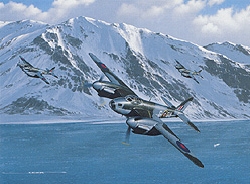|
|
| Those Nagging Mosquitoes |
|
 |

|
 |
|
|
| DESCRIPTION |
 |
| 16 x 11.5 Inch Collector Size Unframed Lithograph $40.00
Although fifty years has passed since the end of WW II the de Havilland Mosquito or "Mossie" is still held in high admiration by the crews which flew this wonderful aircraft. Built in a number of variants the Mosquito served in a number of roles including fighter bomber trainer transport night fighter and reconnaissance aircraft. Prior to WW II the de Havilland Company had built a good reputation for building highly streamlined very fast aircraft utilized for racing. The Company submitted a design proposal in 1939 for an all new twin-engined aircraft primarily built of wood which would be capable of 400 MPH with its twin Merlin engines. Late in 1939 the Air Ministry ordered a prototype and in March of 1940 an initial fifty production aircraft were ordered. The Mosquito was built utilizing a one-piece two-spar wing. Spruce and plywood were utilized extensively. The aircraft performed admirably in its initial tests and the first combat mission took place in September 1941. Some of the early Mosquitoes were produced in a bomber variant. Early Mosquitoes were painted in a unique blue-gray camouflage. One of the first squadrons equipped with the Mosquito was number 105. In September of 1942 105 squadron sent four of its aircraft on a daring daylight low level raid to bomb the Gestapo Headquarters in Oslo Norway. This successful mission was lead by RAF Squadron Leader George Parry. The mission was important because the Gestapo Headquarters housed vital dossiers on Norwegian resistance personnel and the resistance had requested the mission to boost morale. The Mosquitoes were unexpectedly attacked by two Fw-190s as they approached the target. One of the aircraft (piloted by F/Sgt. Carter) was hit and crashed while attempting a force landing on a lake. One of the Fw-190s struck a tree during the chase and crash landed in a mountainous area. Stan Stokes in his striking painting appropriately titled Those Nagging Mosquitoes depicts the three returning aircraft of 105 Squadron flying fast and low over a fjord in Norway. Because the Mossie utilized speed as a way to avoid enemy fighters several minor modifications were made to coax every additional MPH possible out of the aircraft. Other modification were made to some aircraft which allowed them to carry a 4000 pound bomb. The Mosquito was also produced under license in Canada utilizing Packard-manufactured Merlin engines. The Mosquito B Mk IX utilized a pair of 1680 HP Merlin 72s and the prototype attained a speed of 437 MPH. Other Mossies were modified to utilize a bulbous ventral radar dome. The Mosquito was produced until 1950. More than 7700 aircraft were built. The aircraft remained in service with the RAF until 1963. Only a few restored examples of this versatile aircraft remain in existence. |
|


|